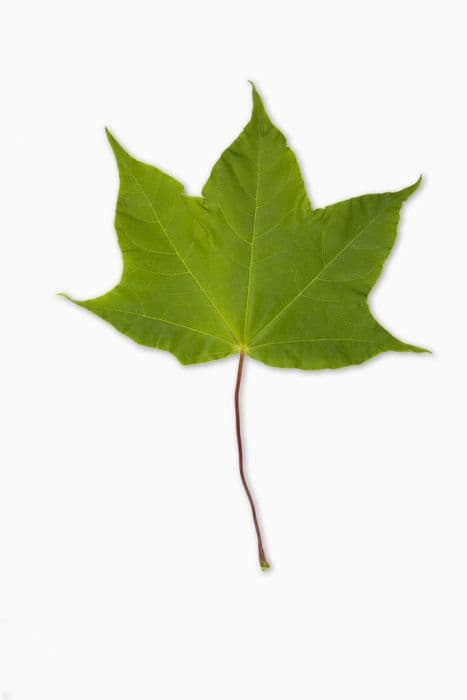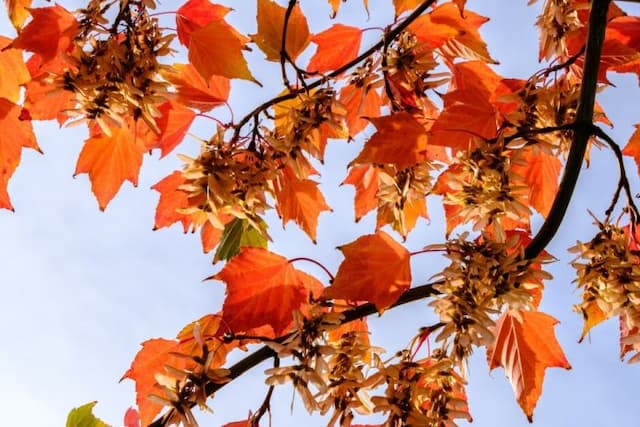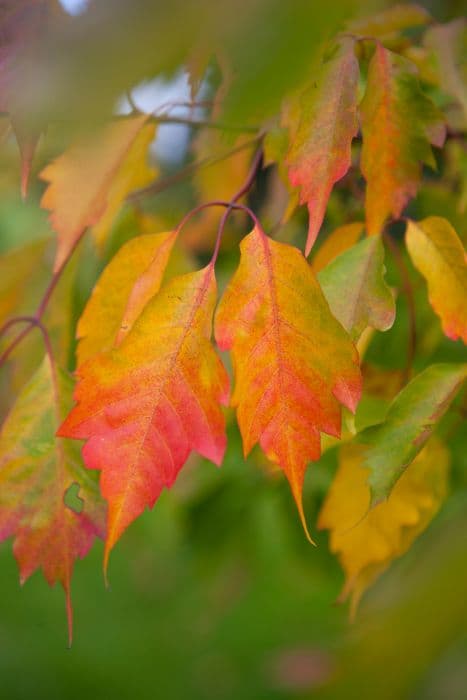Redtwig Striped Maple Acer pensylvanicum 'Erythrocladum'

ABOUT
The Acer pensylvanicum 'Erythrocladum', commonly known as the Red Twig Striped Maple, is a strikingly ornamental tree known for its unique bark and foliage. This tree boasts green leaves that are distinctive with their three-lobed shape, reminiscent of the typical maple leaf silhouette. The edges of the leaves are finely toothed, providing a subtle texture to the foliage. One of the most captivating features of the Red Twig Striped Maple is the bark, which is a smooth, greenish color marked by vertical white stripes, lending a distinctive pattern that stands out in a garden setting. These white stripes are particularly prominent in the winter months when the leaves have fallen and the bare branches reveal the full extent of this characteristic bark patterning. The tree's name 'Erythrocladum' hints at another of its remarkable attributes – the branches and twigs have a reddish tinge that is especially visible during the colder months. This provides a sharp contrast against the snowy or dull winter landscapes, making it a source of vibrant color in the garden when many other plants have become dormant. As the seasons change, the Red Twig Striped Maple offers a dynamic display, with its leaves turning from green to a range of yellows and oranges. These warm autumnal hues add another layer of visual interest to this plant's already diverse palette. In summary, the Red Twig Striped Maple is a beautifully patterned tree with a year-round appeal due to its striking striped bark, reddish twigs, deeply lobed leaves, and seasonal color changes. It serves as an eye-catching specimen in any garden or landscape setting where its ornamental value can be fully appreciated.
About this plant
 Names
NamesFamily
Sapindaceae
Synonyms
Red-stemmed Striped Maple, Erythrocladum Striped Maple
Common names
Acer pensylvanicum 'Erythrocladum'
 Toxicity
ToxicityTo humans
The Acer pensylvanicum 'Erythrocladum', more commonly known as the striped maple, is not known to be toxic to humans. There are no well-documented cases of poisoning from consuming or coming into contact with the striped maple, and it is generally considered safe from a toxicity standpoint.
To pets
Similar to its effects on humans, the striped maple is not known to be toxic to pets. There is no significant evidence to suggest that ingestion of the striped maple by pets would lead to poisoning. Owners should not expect adverse health effects if their pets come into contact with or ingest parts of this plant. However, it is always prudent to monitor pets for any unusual reactions after ingesting any plant material, as individual sensitivities can vary.
 Characteristics
CharacteristicsLife cycle
Perennials
Foliage type
Deciduous
Color of leaves
Green
Flower color
Yellow
Height
20-30 feet (6-9 meters)
Spread
15-25 feet (4.5-7.5 meters)
Plant type
Tree
Hardiness zones
3-7
Native area
North America
Benefits
 General Benefits
General Benefits- Ornamental Appeal: The Acer pensylvanicum 'Erythrocladum', commonly known as the Red Twig Striped Maple, has distinctive red twigs that add a splash of color to the winter landscape.
- Shade Provision: As a medium-sized tree, it can provide pleasant shade and cooling effect to gardens and parks during the sunny months.
- Habitat for Wildlife: Offers a habitat for various species of birds and small mammals, which use the tree for shelter and nesting.
- Seasonal Interest: Exhibits a range of seasonal changes, from spring flowers to summer leaves and vibrant fall foliage, contributing year-round interest to landscapes.
- Low Maintenance: Generally requires minimal upkeep once established; tolerant of a range of soil types and conditions.
- Naturalization: Adapts well to the native woodland settings and can be used for natural landscaping, helping to maintain the local ecosystem balance.
 Medical Properties
Medical PropertiesThis plant is not used for medical purposes.
 Air-purifying Qualities
Air-purifying QualitiesThis plant is not specifically known for air purifying qualities.
 Other Uses
Other Uses- Acer pensylvanicum 'Erythrocladum', commonly known as Red-stemmed Striped Maple, can be utilized in landscape design for winter interest due to its distinctive red bark.
- In woodworking, small pieces of Red-stemmed Striped Maple wood might be used for marquetry or inlays, offering a unique pattern or color contrast.
- With its moderate growth rate and distinctive look, Red-stemmed Striped Maple is often planted as an understory tree in woodland gardens to re-establish natural plant layers.
- Its young, flexible branches can be used in rustic crafts or as natural supports for climbing plants in an informal garden setting.
- In education, Red-styled Striped Maple may serve as a living specimen for botanical studies, especially focusing on plant adaptation and variation within species.
- During winter when food is scarce, the Red-stemmed Striped Maple can be used as a forage plant for wildlife, offering a valuable food source for birds and mammals.
- In larger properties or parks, the Red-stemmed Striped Maple can be part of habitat reclamation projects that aim to reintroduce native plants and support local fauna.
- For artists, leaves and branches from this Maple can be used as stencils or stamps to create natural patterns and prints on paper or fabric.
- Enthusiasts of bonsai may use Red-stemmed Striped Maple for creating miniature landscapes, due to its attractive bark and foliage.
- The tree's fallen leaves can contribute to the creation of leaf mold, a type of compost that is an excellent soil conditioner, benefiting garden beds where it is applied.
Interesting Facts
 Feng Shui
Feng ShuiThe Striped Maple is not used in Feng Shui practice.
 Zodiac Sign Compitability
Zodiac Sign CompitabilityThe Striped Maple is not used in astrology practice.
 Plant Symbolism
Plant Symbolism- Resilience: Acer pensylvanicum 'Erythrocladum', commonly known as the Striped Maple or Pennsylvania Maple, often symbolizes resilience due to its ability to adapt and grow in various soil types and environments.
- Strength: The wood of the Striped Maple is known for its hardness and durability, which lends to its symbolic association with strength and endurance.
- Beauty: With its striking red twigs and beautiful foliage that changes color with the seasons, the Striped Maple represents beauty and the aesthetic pleasures of nature.
- Growth and Renewal: As a deciduous tree, the Striped Maple undergoes a process of renewal every year, shedding its leaves and growing new ones, symbolizing personal growth and the embrace of new beginnings.
- Adaptability: This species' ability to thrive under the canopy of larger trees showcases its adaptability and versatility, qualities that can be seen as symbolic of one's ability to thrive in different life circumstances.
 Water
WaterThe Striped Maple should be watered deeply but infrequently, allowing the soil to dry out slightly between waterings. Typically, young trees need watering once a week with up to 15-20 gallons depending on the size and weather conditions, whereas mature trees may require less frequent watering. During hot or dry periods, increase watering frequency to prevent stress. In winter, reduce watering but do not allow the soil to become completely dry. Adjust the amount and frequency of watering based on rainfall, temperature, and soil moisture content.
 Light
LightThe Striped Maple prefers partial shade to full sun, thriving best in a location that offers some protection from harsh afternoon sunlight. It can tolerate full sun in cooler climates but needs shaded conditions in hotter areas. The ideal lighting condition is dappled sunlight, such as the light filtering through the canopy of larger trees.
 Temperature
TemperatureThe Striped Maple does well in a wide range of temperatures but is best suited to temperatures that typically range from 60°F to 75°F. It can survive minimum temperatures down to -40°F and maximum temperatures up to 90°F, showing good cold hardiness. However, extreme heat can stress the tree, so provide shade during scorching summer months if necessary.
 Pruning
PruningPrune the Striped Maple to maintain shape and health, remove any dead or damaged branches, and encourage airflow. The best time for pruning is late winter to early spring when the tree is dormant and before sap starts flowing. Pruning should be done sparingly, as the tree has a naturally attractive shape, and excessive pruning can stimulate unwanted growth.
 Cleaning
CleaningAs needed
 Soil
SoilThe Striped Maple prefers a well-draining soil rich in organic matter with a pH range of 5.5 to 7.0. A mixture of loam, peat, and sand in equal parts creates an optimal environment for its roots to grow.
 Repotting
RepottingThe Striped Maple, being a large tree, is not typically repotted. It is planted outside where it has room to grow and does not require repotting.
 Humidity & Misting
Humidity & MistingThe Striped Maple thrives in average outdoor humidity levels. Ensure that it is not placed in an overly dry environment to maintain its health.
 Suitable locations
Suitable locationsIndoor
Provide bright indirect light and room to grow.
Outdoor
Plant in partial shade with well-draining soil.
Hardiness zone
3-7 USDA.
 Life cycle
Life cycleAcer pensylvanicum 'Erythrocladum', commonly known as the Redvein Striped Maple, begins its life cycle as a seed, typically germinating in the cool, moist conditions of spring. The seedling phase involves the emergence of the first leaves and establishment of a root system. This is followed by the sapling stage, where vigorous growth occurs and the plant begins to develop its characteristic striped bark and red twigs. As it matures into an adult tree, it undergoes secondary growth, expanding in girth and height, and develops reproductive structures, producing flowers that are pollinated by insects. Successful pollination results in the formation of samaras, the maple's winged seeds, which are dispersed by wind, setting the stage for the next generation. The mature Redvein Striped Maple eventually enters a phase of senescence and will die, decomposing to return nutrients back to the soil.
 Propogation
PropogationPropogation time
Early spring
The most popular method of propagation for the Striped Maple, Acer pensylvanicum 'Erythrocladum', is by seed. The ideal time to collect seeds is in the fall when they are fully ripe and have turned brown. Once collected, the winged seeds can be planted immediately or stratified. Stratification involves mixing the seeds with moist sand and storing them in a plastic bag in the refrigerator for about 90 to 120 days. This cold period mimics winter conditions and helps break the seed's dormancy. After the stratification period, seeds can be sown in well-drained soil and placed in a cold frame or a sheltered outdoor area. Germination usually takes place in the spring, but it can be slow and irregular.









